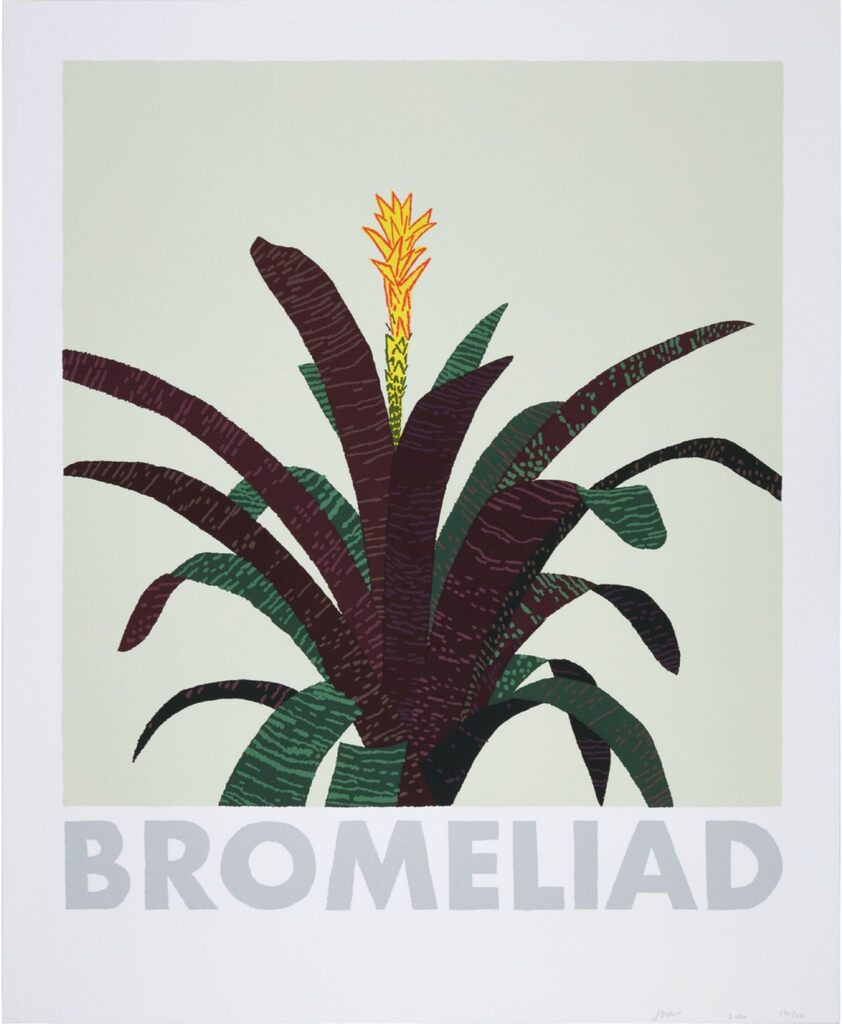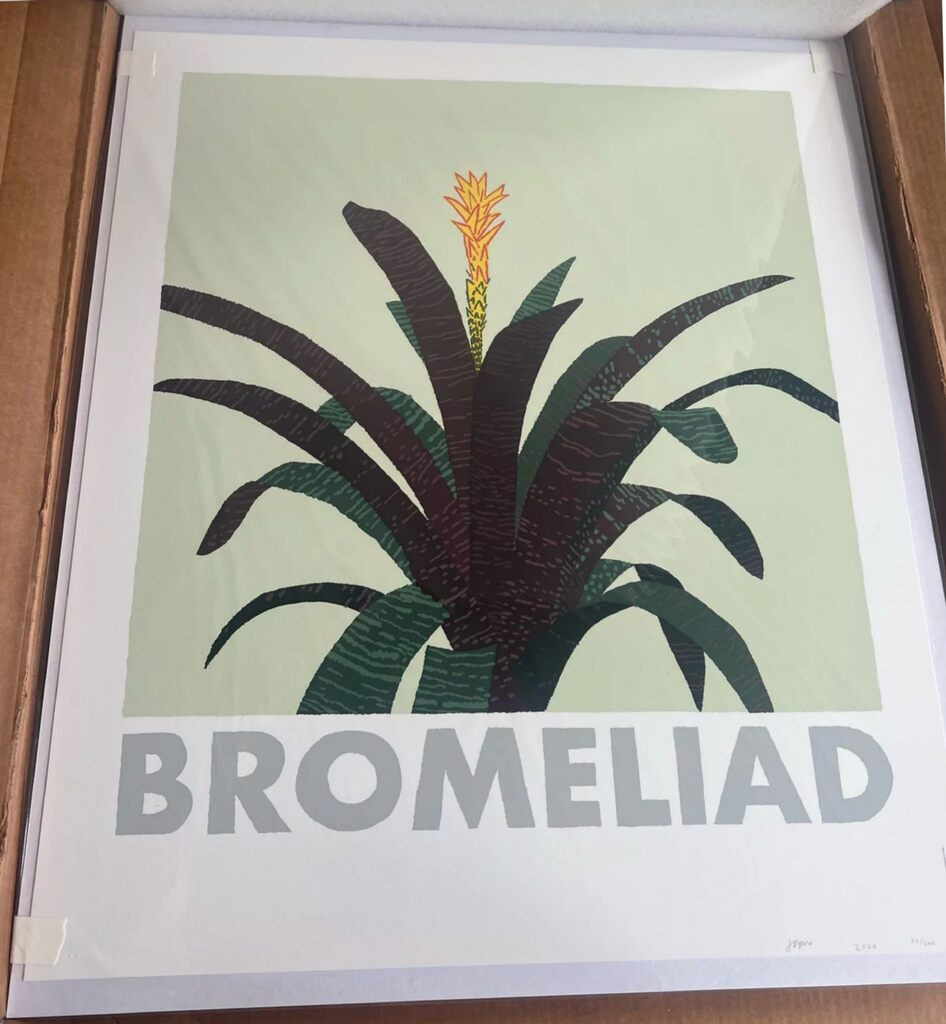
An Educated Collector is Our Best Client
In business for nearly two decades, we are a well established, popular contemporary art boutique specializing in expertly chosen, blue chip prints, multiples, uniques, books, ephemera and merchandise at different price points, with a focus on the secondary market. Please click on the "Contact Us" button at the bottom of this page for questions about any work, pricing and/or to arrange to visit our showroom/gallery - located in between Manhattan's Flatiron and Chelsea Flower Districts.
ALPHA 137 GALLERY
ALPHA 137 GALLERY
Description
Jonas Wood
Bromeliad, 2020
13 Color Screenprint in colors, on rising museum board, with full margins
Signed, dated and numbered 135/200 in pencil front; with publisher's blind stamp
28 × 23 inches
Unframed
Signed, dated and numbered 135/200 in pencil on the front (there were also 25 artist's proofs), published by WKS Editions, Los Angeles (with their blindstamp) for Printed Matter, New York.
This work must ship flat, as it is on rising museum board
JONAS WOOD BIOGRAPHY:
Jonas Wood (b. 1977, Boston) makes paintings that can be classified as a variety of different genres, including portraits, still lifes, landscapes, and interior scenes. In each of these, however, his work reflects an instantly recognizable vision of the contemporary world, as well as a personal approach to subject matter defined by his affinities and experiences. Its warmth is matched by a quasi-abstract logic that breaks pictures down into layered compositions of geometry, pattern, and color. Wood works at every scale, and maintains active drawing and printmaking practices, each of which helps him generate techniques that he eventually uses in paintings. Conjuring depth using flat forms—his process involves collage-based studies in which he works with photographs, breaking images apart and reassembling them—Wood probes the boundary between the new and the familiar, integrating emotionally resonant material from everyday life. Painting becomes a way to freshen the artist’s—and the viewer’s—perception of the world.
What is a Bromeliad?
The bromeliad family is large and varied. Its two best-known members, pineapples and Spanish moss, give an idea of the diversity of this group of plants.
Most bromeliads are easy to grow either indoors or in the greenhouse. They have attractive forms and leaf colors, and many with flowers that can last for months.
Height/Spread
Bromeliads grown as houseplants vary in size from one inch to 2 to 3 feet tall.
Growth Rate
Bromeliads are fairly long-lived and slow-growing houseplants. Although the central plant dies after flowering, they produce “pups” that can be separated and potted up to form new plants.
Ornamental Features
Most bromeliads have very attractive foliage. The leaves may be broad and leathery or fine and wiry. Many are colorfully banded and variegated. Others have silvery-gray scales covering the leaves. In many types of bromeliads, the thick, broad leaves form funnel-shaped rosettes called tanks, which hold water. Many bromeliads also develop beautiful flowering stalks.
Culture
Bromeliads are either terrestrial or epiphytic in their natural habitat. Terrestrial bromeliads require soil for growth, like most plants.
Epiphytic bromeliads do not live in soil but survive by clinging to a tree or other supports such as rocks. Epiphytes are not parasites. They do not harm the host plant in any way, but merely use them for support. Epiphytes obtain all their water and mineral needs from the environment. Epiphytic bromeliads can be grown like a terrestrial one; however, understand the potting mix is insignificant.
Bromeliads need in-direct sunlight to grow well and produce flowers, with a few exceptions. Bromeliads prefer temperatures from 60F to 85F to survive and grow well.
Water bromeliads well and allow the soil to dry before watering again. Many bromeliads hold water in a leaf cup called a “tank.” The tank should be kept filled with water at all times. Be careful when you fill the tank, not to let the water soak the soil. Bromeliads are prone to root rots if the soil is kept wet. Flush the tank periodically by pouring fresh water into it, inverting, and filling again. This will prevent stagnation and buildup of mineral salts.
Proper drainage is essential. The soil mix must be porous enough to allow water to drain off quickly and allow air to reach the roots. It should never be soggy.
Bromeliads need humid air to prosper. Most houses are not moist enough, and you will need to provide humidity for your plants by misting them frequently. This is especially vital for “air plants” that obtain moisture from the air.
Bromeliads need fertilizer but use it at half strength or less during the summer months. Also, mist the leaves in with diluted liquid fertilizer.
You can force bromeliads to flower by placing the plant inside a clear, airtight plastic bag with a ripe apple for two to three days. Depending on the type of plant you have, flowering will begin in six to fourteen weeks. After flowering, the parent plant dies. Offshoots, or pups, provide for the steady renewal of the plant.
-Courtesy Home & Garden Information Center












